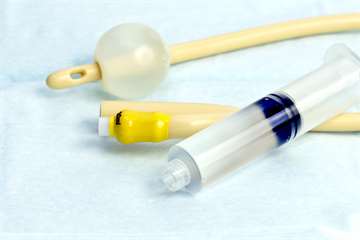What will happen?
You will be given an appointment to have the catheter removed. You may hear medical staff call this a TWOC which is short for 'trial without catheter'.
Removing the catheter
Men are often anxious about this appointment and are concerned that it will be painful. However, having the catheter removed is a simple, relatively painless procedure (men often describe it as a slithery feeling).
2
The nurse will attach a (needleless) syringe to the catheter port and take out the water that is inflating the balloon. Without the balloon to hold it in place in the bladder, the catheter will come out when pulled gently.Prepare yourself, that after the catheter is removed, you will be unable to control your bladder, you may leak small or large amounts of urine. Have some pads ready to put on and some tight-fitting underwear to hold the pad in place.
Don’t worry, this initial leakage is entirely normal and will improve over time. Do not compare yourself to other men at the appointment, they have had a different operation to you and everyone is affected differently
3
The nurse will want to make sure that you can pass urine before you can go home, so after the catheter has been removed you will have to wait and have a drink in the clinic/hospital until you have been to the toilet and passed urine normally. Bring some books or other activities to help pass time whilst you wait.What can I do?
There are things you can do to prepare and to help make this stage easier:
• Bring along a couple of changes of close-fitting underwear and trousers/shorts in a dark colour (more discreet if leaks happen)
• Buy some packs of absorbent (incontinence) pads in both light and heavy absorbencies; you can buy these from most supermarkets and chemists.
• If you haven’t done so already, contact PCUK to request a surgery support pack which includes samples of pads and other advice. Alternatively call their helpline 0800 0748383.
• Plan how to get to and from the appointment. If you are going to be travelling by car you could bring a disposable mat or towel to sit on in the car in case you leak on the way home.
• If you have to take public transport you may want to think about what to wear so you can hide any unexpected accidents/leaks. Perhaps think through where the toilets are on your way home so you are prepared if you need to go urgently.
• You can get a card to show in shops or restaurants to show that you have a medical condition and may need to use a toilet urgently. It doesn't guarantee access but it might make it easier to ask.
Anything else I need to know?
• Very rarely there might be a problem and you find that you are unable to pass urine (you may hear this called ‘retention of urine’), you may need to have the catheter re-inserted for the time being. The medical team will make a plan to try removing the catheter again at a future date, you may hear this called a TWOC (Trial without catheter).
• When you get home if you struggle to pass urine or you experience any of the following, contact your GP or your medical team:
-
Weak urine stream
-
Straining to start the stream
-
Urine stream stops and starts
-
You cannot pass your water (urine) at all this is called 'retention of urine'